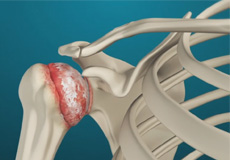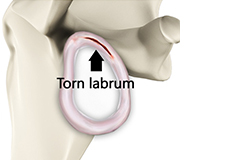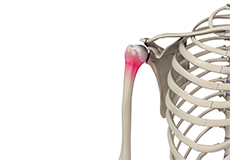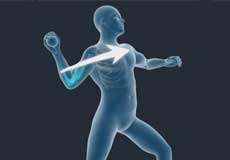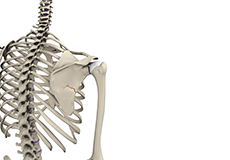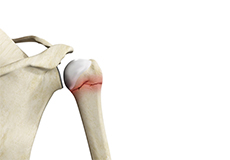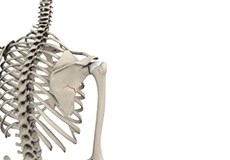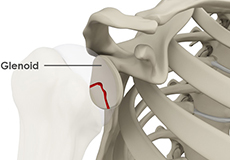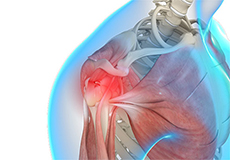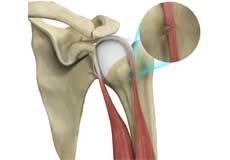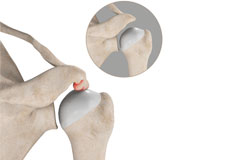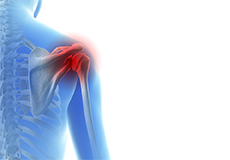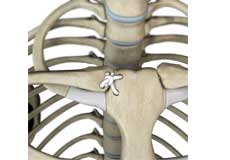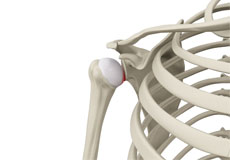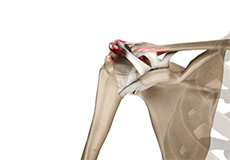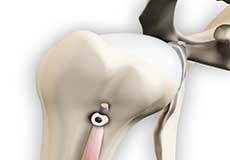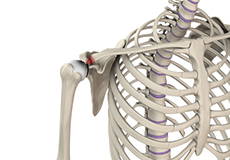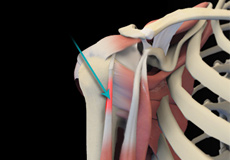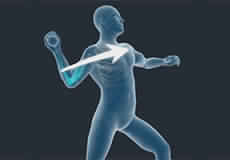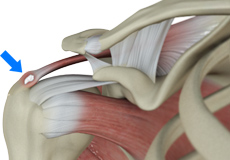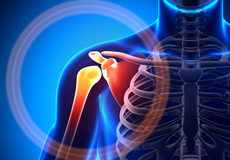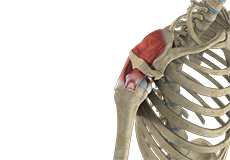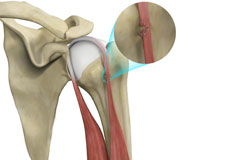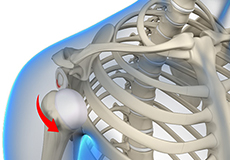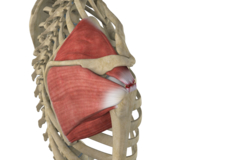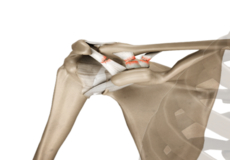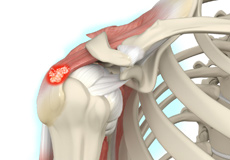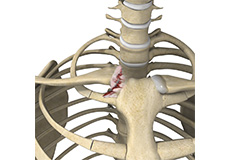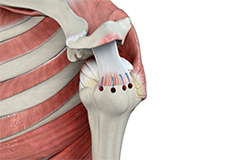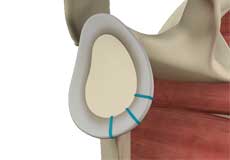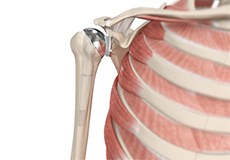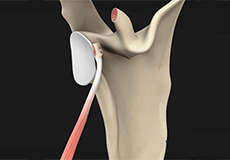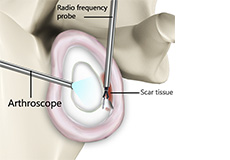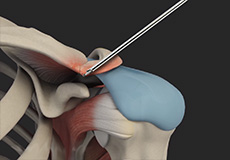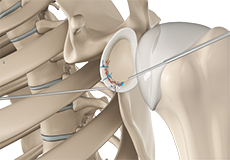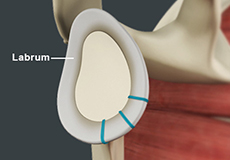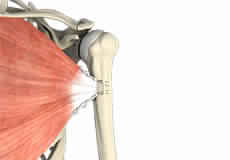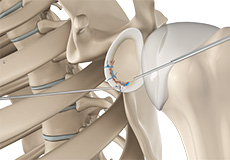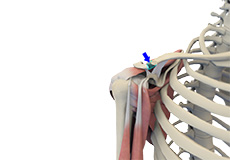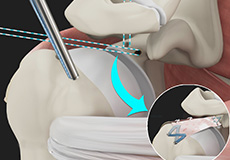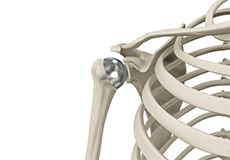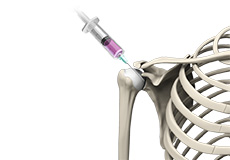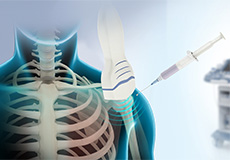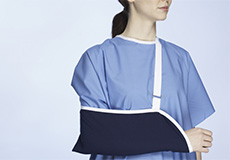Arthritis of the Shoulder
The term arthritis literally means inflammation of a joint but is generally used to describe any condition in which there is damage to the cartilage. Damage of the cartilage in the shoulder joint causes shoulder arthritis. Inflammation is the body's natural response to injury. The warning signs that inflammation presents are redness, swelling, heat, and pain.
Rotator Cuff Tear
A rotator cuff is a group of tendons in the shoulder joint that provides support and enables a wide range of motion. A major injury to these tendons may result in rotator cuff tears. It is one of the most common causes of shoulder pain in middle-aged and older individuals.
Shoulder Labral Tear
Traumatic injury to the shoulder or overuse of the shoulder (throwing, weightlifting) may cause the labrum to tear. In addition, aging may weaken the labrum leading to injury.
Shoulder Dislocation
Sports that involve overhead movements and repeated use of the shoulder at your workplace may lead to sliding of the upper arm bone from the glenoid. The dislocation might be a partial dislocation (subluxation) or a complete dislocation causing pain and shoulder joint instability. The shoulder joint often dislocates in the forward direction (anterior instability), and sometimes in the backward or downward direction.
Shoulder Instability
Shoulder instability is a chronic condition that causes frequent dislocation of the shoulder joint.
SLAP Tears
The term SLAP (superior –labrum anterior-posterior) lesion or SLAP tear refers to an injury of the superior labrum of the shoulder.
Shoulder Pain
Pain in the shoulder may suggest an injury, which is more common in athletes participating in sports such as swimming, tennis, pitching, and weightlifting. The injuries are caused due to the over usage or repetitive motion of the arms.
Little League Shoulder
Little league shoulder is an injury to the growth plate of the upper arm bone at the shoulder joint of children. It is an overuse injury caused by repeated pitching or throwing, especially in children between the ages of 10 to 15 years. This condition is mostly seen in baseball pitchers, but children in other sports who use improper throwing action are also at risk.
Frozen Shoulder
Frozen shoulder, also called adhesive capsulitis, is a condition in which you experience pain and stiffness in your shoulder. The symptoms appear slowly, worsen gradually and usually take one to three years to resolve on their own.
Overhead Athlete's Shoulder
An overhead athlete is at increased risk of injury due to the mechanism associated with rapid shoulder elevation, external rotation, and abduction. An overhead throwing motion is an intricate and skillful movement that presents a special challenge of needing the glenohumeral joint to surpass its physiologic limits during overhead sports activities.
Anterior Shoulder Instability
Anterior shoulder instability, also known as anterior glenohumeral instability, is a condition in which damage to the soft tissues or bone causes the head of the humerus (upper arm bone) to dislocate or sublux from the glenoid fossa, compromising the function of the shoulder. It is caused by trauma or injury to the glenohumeral joint in which the upper arm bone is dislodged from its usual position in the middle of the glenoid fossa, and there is no longer joint articulation. Anterior shoulder instability accounts for 95 percent of all acute traumatic shoulder dislocations.
Posterior Shoulder Instability
Posterior shoulder instability, also known as posterior glenohumeral instability, is a condition in which the head of the humerus (upper arm bone) dislocates or subluxes posteriorly from the glenoid (socket portion of the shoulder) as a result of significant trauma. A partial dislocation is referred to as a subluxation whereas a complete separation is referred to as a dislocation.
Snapping Scapula
Snapping scapula or snapping scapula syndrome is also known as scapulothoracic syndrome or scapulocostal syndrome. It is a condition characterized by painful clicking, snapping, or grinding of the shoulder blade. The sound occurs as a result of rubbing of soft tissues between the thoracic wall and the scapula. The soft tissues stuck in between these two structures may be a muscle, tendon, or bursa. Snapping scapula is most commonly found in young and active individuals who are involved in repetitive overhead activities.
Shoulder Impingement
Shoulder impingement is the inflammation of the tendons of the shoulder joint. It is one of the most common causes of pain in the shoulder. Shoulder impingement is also called swimmer’s shoulder, tennis shoulder or rotator cuff tendinitis.
Shoulder Fracture
The shoulder is the most flexible joint in the body, enabling a wide range of movements. It is a ball-and-socket joint made up of three bones, namely the humerus (upper arm bone), scapula (shoulder blade) and clavicle. The head of the humerus articulates with the socket of the scapula called the glenoid cavity. The clavicle bone or collarbone is an S-shaped bone that connects the scapula to the sternum or breastbone. It forms two joints: the acromioclavicular joint, where it articulates with the acromion process of the scapula, and the sternoclavicular joint, where it articulates with the sternum or breast bone. Tendons and ligaments around the shoulder joint provide strength and stability to the joint.
Fracture of the Shoulder Blade (Scapula)
The scapula (shoulder blade) is a flat, triangular bone providing attachment to the muscles of the back, neck, chest and arm. The scapula has a body, neck and spine portion.
Clavicle Fracture
The break or fracture of the clavicle (collarbone) is a common sports injury associated with contact sports such as football and martial arts, as well as impact sports such as motor racing. A direct blow over the shoulder that may occur during a fall on an outstretched arm or a motor vehicle accident may cause the clavicle bone to break.
Glenoid Fractures
Fractures of the glenoid are rare but can occur due to major trauma or during high-energy sports activities.
Shoulder Trauma
Shoulder injuries most commonly occur in athletes participating in sports such as swimming, tennis, pitching, and weightlifting. The injuries are caused due to the over usage or repetitive motion of the arms.
Proximal Humerus Fractures
Fractures of the proximal humerus are common in elderly individuals suffering from osteoporosis. In younger individuals, a severe trauma such as a fall from a height on an outstretched hand or motor vehicle accident can cause these fractures.
Subacromial Impingement Syndrome
SAIS is the inflammation and irritation of your rotator cuff tendons. This occurs when the tendons rub against the outer end of the shoulder blade (the acromion) while passing through the subacromial space during shoulder movement.
Baseball and Shoulder Injuries
Shoulder injuries in baseball players are usually associated with pitching. While this overhand throwing activity can produce great speed and distance for the ball, when performed repeatedly, can place a lot of stress on the shoulder. While pitching, the arm is thrown outward and backward to generate speed. This action forces the head of the humerus forward, stressing the surrounding ligaments and tendons. These stresses can lead to injuries, causing pain and inflammation.
Sternoclavicular Joint (SC joint)
The sternoclavicular joint is the joint between the breastbone (sternum) and the collar bone (clavicle). The SC joint is one of the 4 joints that complete the shoulder and is the only joint that links the arm to the body. Like any other joints, the SC joint is covered by articular cartilage that helps the bones slide effortlessly against each other during arm and shoulder movement. Tough connective tissue known as ligaments surrounds the SC joint providing stability and strength.
Subluxation
The shoulder is a highly mobile ball and socket joint. The ball of the upper arm bone (humerus) is held in place at the socket (glenoid) of the shoulder blade (scapula) by a group of ligaments. A partial dislocation of the shoulder joint is termed as a subluxation. This means the ball has partially moved out of the glenoid as opposed to a dislocation, where the ball completely moves out of the glenoid.
Acromioclavicular (AC) Joint Osteoarthritis
Osteoarthritis also called degenerative joint disease, is the most common form of arthritis. It occurs most often in older people. AC joint osteoarthritis affects the tissue covering the ends of bones (cartilage) in the AC joint of the shoulder. The cartilage becomes damaged and worn out causing pain, swelling, stiffness and restricted movement in the AC joint.
Proximal Biceps Tendinitis
Proximal biceps tendinitis is the irritation and inflammation of the biceps tendon at the shoulder joint. The biceps muscle is the muscle of the upper arm which is necessary for the movement of the shoulder and elbow. It is made of a ‘short head’ and a ‘long head’ which function together. The long head of the biceps tendon is attached at the top of the shoulder joint. The short head is attached to your shoulder blade.
Internal Impingement of the Shoulder
Internal shoulder impingement can be described as a pathological condition resulting from repetitive impingement of the internal surface of the rotator cuff by the bones at the back of the glenohumeral joint.
Rotator Cuff Re-tear
Rotator cuff repair is a surgery to repair an injured or torn rotator cuff. A re-tear may occur a few years after surgery due to multiple reasons including aging, a massive previous tear (more than 5cm), fatty degradation of the tendons, inflammatory arthritis, and inappropriate rehabilitation.
AC Joint Separation
AC joint separation, also known as shoulder separation, is a condition characterized by damage to the ligaments that connect the acromion to the collar bone. As a result, the bones do not line up properly, causing joint pain and instability.
Shoulder Tendonitis
Shoulder tendonitis is a condition characterized by inflammation of the tendons which connect the muscles to the shoulder bones. Tendonitis of the rotator cuff tendons is known as rotator cuff tendonitis. If the biceps tendon is affected, the condition is known as bicipital tendonitis.
Throwing Injuries of the Shoulder
Throwing injuries of the shoulder are injuries sustained as a result of trauma by athletes during sports activities that involve repetitive overhand motions of the arm as in baseball, American football, volleyball, rugby, tennis, track and field events, etc. Throwing injuries are mostly seen in the shoulder and elbow and can occur due to improper techniques, training errors, muscle imbalance, and overuse of muscles.
Acromioclavicular (AC) Arthritis
The acromioclavicular joint is part of the shoulder joint. It is formed by the union of the acromion, a bony process of the shoulder blade, and the outer end of the collar bone or clavicle. The joint is lined by cartilage that gradually wears with age as well as with repeated overhead or shoulder level activities such as basketball. The condition is referred to as AC arthritis or acromioclavicular arthritis.
Rotator Cuff Calcification
Rotator cuff calcification is the abnormal accumulation of calcium deposits in rotator cuff muscles and tendons. The rotator cuff is a group of 4 muscles and tendons in the shoulder joint that join the head of the humerus to the shoulder. It forms a sleeve around the humeral head and glenoid cavity, providing additional stability to the shoulder joint while enabling a wide range of mobility. Calcium accumulation in this region obstructs and limits the normal range of motion of your arm and causes significant shoulder pain and discomfort.
Shoulder Disorders
The shoulder is the most flexible joint in the body that enables a wide range of movements. Aging, trauma or sports activities can cause injuries and disorders that can range from minor sprains or strains to severe shoulder trauma.
Partial Rotator Cuff Tear
A partial rotator cuff tear is an incomplete tear that involves damage to a part of the tendon. The tear can be at the top, bottom or inner side of the tendon and does not go all the way through the tendon completely.
Bicep Tendon Rupture
Overuse and injury can cause fraying of the biceps tendon and eventual rupture. A biceps tendon rupture can either be partial, where it does not completely tear the tendon or complete, where the tendon completely splits in two and is torn away from the bone.
Shoulder Labral Tear with Instability
The shoulder consists of a ball-and-socket joint formed by the upper end of the humerus (upper arm bone) and a cavity in the shoulder blade called the glenoid. The glenoid cavity is surrounded by a rim of cartilage called the labrum. The labrum adds depth to the cavity making the joint more stable and positions the ball within the socket.
Proximal Biceps Tendon Rupture
The biceps muscle is the muscle of the upper arm which is necessary for the movement of the shoulder and elbow. It is made of a ‘short head’ and a ‘long head’ which function together. These are connected to the shoulder joint by two tendons called the proximal biceps tendons and to the elbow joint by a single distal biceps tendon.
Multidirectional Instability of the Shoulder
Instability may be described by the direction in which the humerus is subluxated or dislocated from the glenoid. When it occurs in several directions it is referred to as multidirectional instability.
Massive Retracted Rotator Cuff Tear
A tear in the rotator cuff can cause pain and disability. It can occur from degeneration of the rotator cuff due to overuse or from a sudden injury. Massive rotator cuff tears involve tears in two complete tendons of the rotator cuff. A tear of more than 5 cm is described as massive. A massive tear may be associated with degeneration and retraction of the tendon and can be difficult to repair if treatment is delayed.
AC Joint Dislocation/Acromioclavicular Joint Dislocation
A dislocation occurs when the ends of your bones are partially or completely moved out of their normal position in a joint. A partial dislocation is referred to as a subluxation, whereas a complete separation is referred to as a dislocation.
Calcification Tendinitis
Calcification tendinitis is a problem with the shoulder’s tendons and muscles. This condition occurs due to the formation of calcium deposits in the tendons (tissue which attaches muscle to bone) of the rotator cuff (a group of muscles and tendons stabilizing the shoulder). This calcium build-up causes inflammation of the tissues surrounding it, and intense shoulder pain. The space between the rotator cuff and the acromion (outer bony end of the shoulder blade) is also reduced due to the calcium deposits, affecting the normal functioning of the rotator cuff.
Rotator Cuff Pain
The rotator cuff consists of a group of tendons and muscles that surround and stabilize the shoulder joint. These tendons allow a wide range of movement of the shoulder joint across multiple planes. Irritation or injury to these tendons can result in rotator cuff pain.
Shoulder Arthroscopy
Arthroscopy is a minimally invasive diagnostic and surgical procedure performed for joint problems. Shoulder arthroscopy is performed using a pencil-sized instrument called an arthroscope. The arthroscope consists of a light system and camera that projects images of the surgical site onto a computer screen for your surgeon to clearly view. Arthroscopy is used to treat disease conditions and injuries involving the bones, cartilage, tendons, ligaments, and muscles of the shoulder joint.
Sternoclavicular Joint Reconstruction
Sternoclavicular joint reconstruction is a surgical procedure employed to repair and restore full function of a damaged sternoclavicular joint.
Rotator Cuff Repair
Rotator cuff repair is a surgery to repair an injured or torn rotator cuff. It is usually performed arthroscopically on an outpatient basis. An arthroscope, a small, fiber-optic instrument consisting of a lens, light source, and video camera. The camera projects images of the inside of the joint onto a large monitor, allowing your doctor to look for any damage, assess the type of injury and repair it. Large rotator cuff tears may require open surgery.
SLAP Repair
A SLAP repair is an arthroscopic shoulder procedure to treat a specific type of injury to the labrum called a SLAP tear.
Shoulder Stabilization
Shoulder stabilization surgery is performed to improve stability and function to the shoulder joint and prevent recurrent dislocations. It can be performed arthroscopically, depending on your particular condition, with much smaller incisions. Arthroscopic stabilization is a surgical procedure to treat chronic instability of the shoulder joint.
Bicep Tendon Rupture at Shoulder
Overuse and injury can cause fraying of the biceps tendon and eventual rupture. A biceps tendon rupture can either be partial, where it does not completely tear the tendon or complete, where the tendon completely splits in two and is torn away from the bone.
Shoulder Joint Replacement
Total shoulder replacement surgery is performed to relieve symptoms of severe shoulder pain and disability due to arthritis. In this surgery, the damaged articulating parts of the shoulder joint are removed and replaced with artificial prostheses. Replacement of both the humeral head and the socket is called a total shoulder replacement.
Reverse Shoulder Replacement
Conventional surgical methods such as total shoulder joint replacement are not very effective in the treatment of rotator cuff arthropathy. Reverse total shoulder replacement is an advanced surgical technique specifically designed for rotator cuff tear arthropathy, a condition where you suffer from both shoulder arthritis and a rotator cuff tear.
Proximal Biceps Tenodesis
Proximal biceps tenodesis is the surgical reattachment of a torn proximal biceps tendon, which connects the upper part of your biceps muscle to the shoulder.
Latarjet Procedure
The shoulder joint provides a wide range of movement to the upper extremity, but overuse or trauma can cause instability to the joint. The Latarjet procedure is a surgical procedure performed to treat shoulder instability by relocating a piece of bone with an attached tendon to the shoulder joint.
Capsular Release
A capsular release of the shoulder is surgery performed to release a tight and stiff shoulder capsule, a condition called frozen shoulder or adhesive capsulitis. The procedure is usually performed arthroscopically through keyhole-size incisions.
AC Joint Stabilisation
Acromioclavicular (AC) joint stabilization is a surgical procedure employed to treat severe cases of AC joint dislocation. AC joint stabilization surgery involves repairing the torn tendons and ligaments or replacing them with either natural tissue grafts obtained from your own body (autograft) or donor (allograft) from the anterior tibia/hamstring or by using an artificial synthetic graft, which helps to hold the AC joint firmly in its position and prevent recurrent pain and instability.
SC Joint Injury Reconstruction
The sternoclavicular (SC) joint is the joint between the breastbone (sternum) and the collar bone (clavicle). Injuries to this joint are called sternoclavicular joint injuries and can include stretching or tearing of the ligaments. It is usually caused due to severe trauma or a direct blow to the side of your body such as in motor vehicle accidents or contact sports.
Arthroscopic Bankart Repair
The labrum can sometimes tear during a shoulder injury. A specific type of labral tear that occurs when the shoulder dislocates is called a Bankart tear. This is a tear to a part of the labrum called the inferior glenohumeral ligament and is common in the young who sustain a dislocation of the shoulder. A Bankart tear makes the shoulder prone to repeat dislocation in patients under 30 years of age.
Shoulder Labrum Reconstruction
Traumatic injury to the shoulder or overuse of the shoulder by excessive throwing or weightlifting can cause a labral tear. In addition, the aging process may weaken the labrum, leading to injury secondary to wear and tear.
Distal Clavicle Excision
Distal clavicle excision is a procedure which involves removal of the outer end of the clavicle (collarbone) to treat shoulder pain and disability due to arthritis or impingement.
Pectoralis Major Tears/Repairs
A tear in the pectoralis major muscle occurs when the tendon attaching the muscle to the upper arm bone is damaged as a result of trauma or injury. In the case of a rupture, operative treatment is employed for repairing the torn muscle in active and young patients irrespective of the chronicity of the injury. The most commonly used techniques to repair a pectoralis major tear are suture anchors and bone tunnel procedures.
Bony Instability Reconstruction of the Shoulder
The shoulder is the most flexible joint in the body. Injury and trauma can tear or stretch the labrum and/or ligaments, causing loosening and instability of the shoulder joint which can lead to partial or complete dislocation of the joint. Bony instability, also known as shoulder instability or glenohumeral instability, refers to the inability to retain the head of the humerus in the glenoid socket due to serious trauma sustained by the soft tissues, and glenoid and humeral bones of the shoulder joint.
Mumford Distal Clavicle Excision
A Mumford distal clavicle excision is a surgical procedure which involves excision or resection of the outer (distal) end of the clavicle, also called the collar bone.
Arthroscopic Superior Capsular Reconstruction (SCR)
Superior Capsular Reconstruction is a surgical procedure to repair massive, irreparable rotator cuff tears. The surgery involves reconstruction of the superior capsule of the shoulder joint using an autograft (tissue from the same person) or an allograft (tissue from a donor).
Subacromial Decompression
Subacromial decompression is a surgical procedure performed for the treatment of a condition called shoulder impingement. In shoulder impingement, the degree of space between the rotator cuff tendon and shoulder blade is decreased due to irritation and swelling of the bursa or due to development of bone spurs. Subacromial decompression opens this space by removing the bony spurs or any inflamed or swollen bursa enabling free shoulder movement.
Shoulder Resurfacing
The shoulder is an active joint is prone to injuries and may also get affected by conditions such as arthritis, which results in impaired functioning and related discomfort. The traditional method of treatment for such conditions is shoulder joint replacement. However, advances in technology have resulted in a superior alternative technique known as shoulder resurfacing.
Acromioclavicular (AC) Joint Reconstruction
The acromioclavicular joint is part of the shoulder joint. It is formed by the union of the acromion, a bony process of the shoulder blade, and the outer end of the collar bone or clavicle. The joint is lined by cartilage that gradually wears with age as well as with repeated overhead or shoulder level activities such as basketball. The condition is referred to as AC arthritis or acromioclavicular arthritis.
Intraarticular Shoulder Injection
The shoulder is prone to different kinds of injuries and inflammatory conditions. An intraarticular shoulder injection is a minimally invasive procedure to treat pain and improve shoulder movement. It may be performed with the help of ultrasound or fluoroscopic imaging which allows your physician to precisely target the intraarticular space.
Ultrasound-Guided Shoulder Injections
An ultrasound is a common imaging technique that employs high-frequency sound waves to create images of organs and other internal structures of the body. These images provide valuable information about the underlying pathology of tissues and assists with diagnosis and planning the treatment of a condition. The ultrasound provides a clear view of organs, tendons, muscles and joints, and any associated disorders.
Non-surgical Shoulder Treatments
Physical therapy is beneficial to shoulder restoration. The therapy can help in strengthening the shoulder joint and restoring its functionality. It can also help with the prevention of recurring shoulder pain after the injury is treated. Moreover, physical therapy can help you learn proper shoulder movements, lifting techniques, and exercises that help reduce unnecessary strain on the joint during every-day activities again preventing future discomfort or injury.

The shoulder is the most flexible joint in the body that enables a wide range of movements including forward flexion, abduction, adduction, external rotation, internal rotation, and 360-degree circumduction. Thus, the shoulder joint is considered the most insecure joint of the body, but the support of ligaments, muscles, and tendons function to provide the required stability.
Bones of the Shoulder
The shoulder joint is a ball and socket joint made up of three bones, namely the humerus, scapula, and clavicle.
Humerus
The end of the humerus or upper arm bone forms the ball of the shoulder joint. An irregular shallow cavity in the scapula called the glenoid cavity forms the socket for the head of the humerus to fit in. The two bones together form the glenohumeral joint, which is the main joint of the shoulder.
Scapula and Clavicle
The scapula is a flat triangular-shaped bone that forms the shoulder blade. It serves as the site of attachment for most of the muscles that provide movement and stability to the joint. The scapula has four bony processes - acromion, spine, coracoid and glenoid cavity. The acromion and coracoid process serve as places for attachment of the ligaments and tendons.
The clavicle bone or collarbone is an S-shaped bone that connects the scapula to the sternum or breastbone. It forms two joints: the acromioclavicular joint, where it articulates with the acromion process of the scapula and the sternoclavicular joint where it articulates with the sternum or breast bone. The clavicle also forms a protective covering for important nerves and blood vessels that pass under it from the spine to the arms.
Soft Tissues of the Shoulder
The ends of all articulating bones are covered by smooth tissue called articular cartilage, which allows the bones to slide over each other without friction, enabling smooth movement. Articular cartilage reduces pressure and acts as a shock absorber during movement of the shoulder bones. Extra stability to the glenohumeral joint is provided by the glenoid labrum, a ring of fibrous cartilage that surrounds the glenoid cavity. The glenoid labrum increases the depth and surface area of the glenoid cavity to provide a more secure fit for the half-spherical head of the humerus.
Ligaments of the Shoulder
Ligaments are thick strands of fibers that connect one bone to another. The ligaments of the shoulder joint include:
- Coracoclavicular ligaments: These ligaments connect the collarbone to the shoulder blade at the coracoid process.
- Acromioclavicular ligament: This connects the collarbone to the shoulder blade at the acromion process.
- Coracoacromial ligament: It connects the acromion process to the coracoid process.
- Glenohumeral ligaments: A group of 3 ligaments that form a capsule around the shoulder joint and connect the head of the arm bone to the glenoid cavity of the shoulder blade. The capsule forms a watertight sac around the joint. Glenohumeral ligaments play a very important role in providing stability to the otherwise unstable shoulder joint by preventing dislocation.
Muscles of the Shoulder
The rotator cuff is the main group of muscles in the shoulder joint and is comprised of 4 muscles. The rotator cuff forms a sleeve around the humeral head and glenoid cavity, providing additional stability to the shoulder joint while enabling a wide range of mobility. The deltoid muscle forms the outer layer of the rotator cuff and is the largest and strongest muscle of the shoulder joint.
Tendons of the Shoulder
Tendons are strong tissues that join muscle to bone allowing the muscle to control the movement of the bone or joint. Two important groups of tendons in the shoulder joint are the biceps tendons and rotator cuff tendons.
Bicep tendons are the two tendons that join the bicep muscle of the upper arm to the shoulder. They are referred to as the long head and short head of the bicep.
Rotator cuff tendons are a group of four tendons that join the head of the humerus to the deeper muscles of the rotator cuff. These tendons provide more stability and mobility to the shoulder joint.
Nerves of the Shoulder
Nerves carry messages from the brain to muscles to direct movement (motor nerves) and send information about different sensations such as touch, temperature, and pain from the muscles back to the brain (sensory nerves). The nerves of the arm pass through the shoulder joint from the neck. These nerves form a bundle at the region of the shoulder called the brachial plexus. The main nerves of the brachial plexus are the musculocutaneous, axillary, radial, ulnar and median nerves.
Blood vessels of the Shoulder
Blood vessels travel along with the nerves to supply blood to the arms. Oxygenated blood is supplied to the shoulder region by the subclavian artery that runs below the collarbone. As it enters the region of the armpit, it is called the axillary artery and further down the arm, it is called the brachial artery.
The main veins carrying de-oxygenated blood back to the heart for purification include:
- Axillary vein: This vein drains into the subclavian vein.
- Cephalic vein: This vein is found in the upper arm and branches at the elbow into the forearm region. It drains into the axillary vein.
- Basilic vein: This vein runs opposite the cephalic vein, near the triceps muscle. It drains into the axillary vein.





